Top Tier CPU Air Coolers Q3 2015: 9-Way Roundup Review
by E. Fylladitakis on July 6, 2015 8:00 AM ESTThe Reeven Okeanos RC-1402
Reeven is a Taiwanese newcomer in the industry. Naturally, most people reading this probably never even heard the company name before today. The company was founded just over a year ago and currently only offers CPU coolers, fans and fan controllers. Reeven sent us their most powerful CPU cooler as well, the Okeanos (RC-1402).
The box that the Reeven comes supplied in is relatively small. Nevertheless, the protection appears adequate, with polyethylene foam protecting the cooler and the bundled items packed inside a cardboard box.
The bundle is a little crudely packed and virtually kept to a minimum. Reeven supplies only the hardware necessary for the mounting of the cooler, a single dose of thermal grease, wire clips for up to three cooling fans, speed reducers for the two provided fans and a leaflet with basic installation instructions.
Reeven supplies two cooling fans alongside with the Okeanos, one 120 mm and one 140 mm fan. Both fans have black frames and genista yellow blades. These are relatively simple models, with sleeve bearings, lacking fancy blades or vibration absorbers. There is one thing of note about these two fans though: they are ridiculously powerful, with the 140 mm and the 120 mm fan rated for a maximum speed of 1700 RPM and 1800 RPM respectively.
The Okeanos is a symmetric dual tower CPU cooler, with strangely narrow towers for its class. Although the difference is very small, the fins of each tower are not precisely geometrically symmetric, with the front side having three small and the rear side one long indentations. The top fin is a 1 mm thick aluminum cover with the company logo punched on it.
The wire fan installation clips do allow moving the front fan upwards in order to gain some RAM clearance - as long as the case is wide enough, of course. Installation-wise, they are a bit of a pain, as Reeven's approach is far too crude, with the wire clips just going straight into the fan holes and clipping onto the side of the fan.
Furthermore, the frame of the 120 mm fan just barely touches the extruded sides of the fins. It is very easy for the 120 mm fan to be installed with only one side on the extruded fins, increasing noise and reducing performance.
Even though the Okeanos initially looks very simple, the bottom of the cooler makes it very interesting. The base is split between a nickel-plated copper lower part and a steel top part, providing mechanical cohesion and retention. In between these two parts, there are six heatpipes, secured with a very generous amount of solder. The two central heatpipes are 8 mm thick, while the other four heatpipes are 6 mm thick, making this the only cooler with an asymmetric heatpipe configuration in our review. The contact surface is well polished and free of imperfections, yet not machined down to a perfect mirror finish.


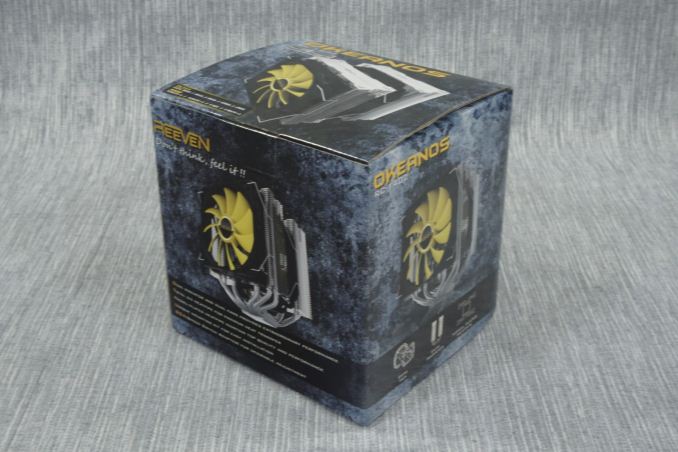
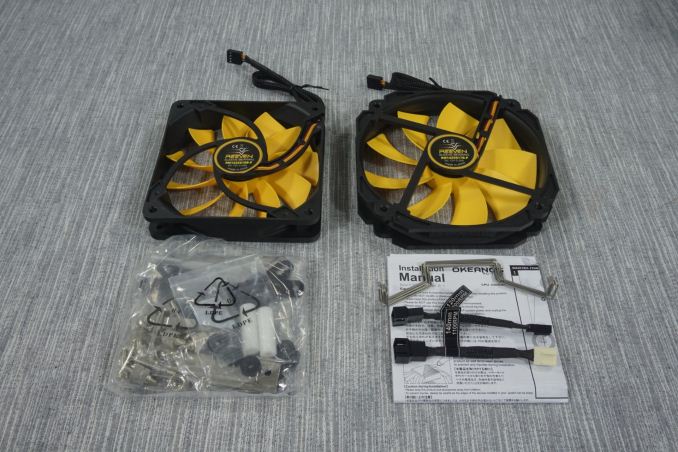
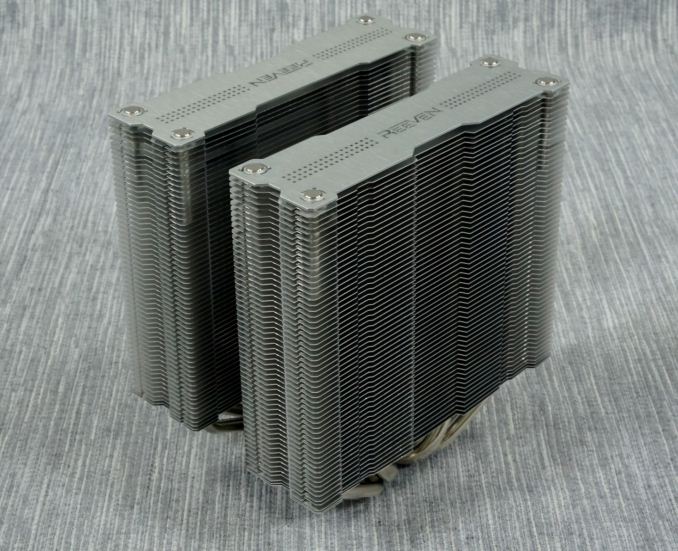
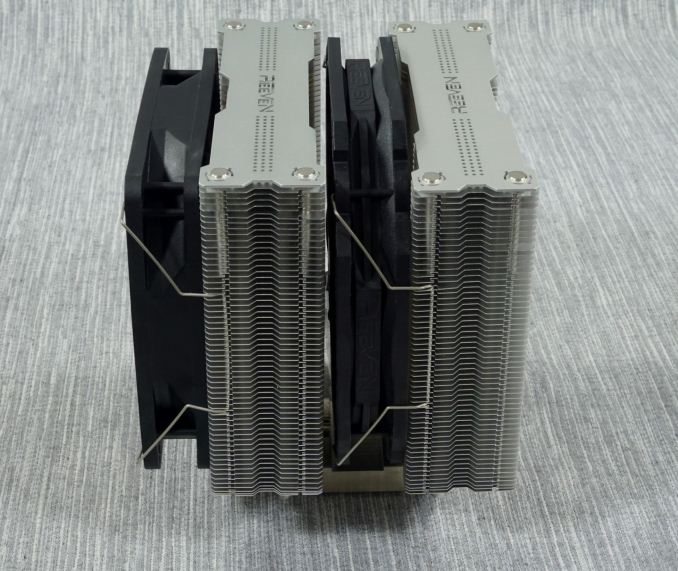
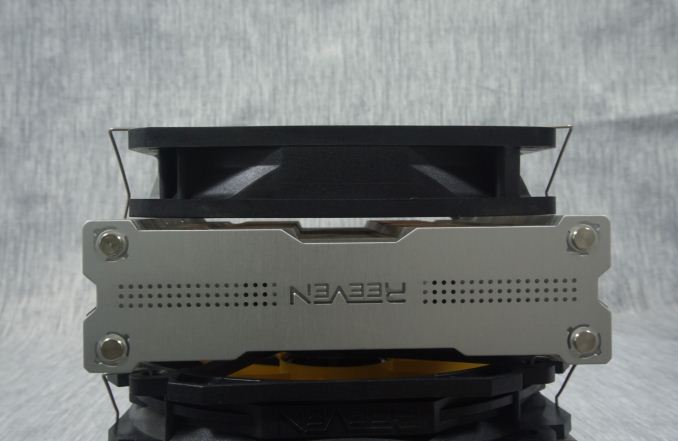
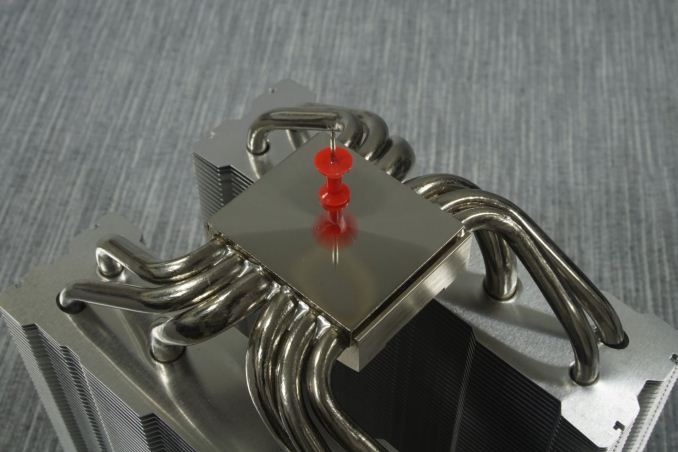








135 Comments
View All Comments
Peichen - Monday, July 6, 2015 - link
I expect many R9 Fury X users are shopping for large air-cooler now as they have to give up their AIO CPU-cooler to Fury.BTW, I really wish you added a Hyper 212X as reference.
meacupla - Monday, July 6, 2015 - link
You could just buy a case like the Fractal Design Define S, which could fit two separate 120mm CLLC in the front, allowing both to get fresh air.Flunk - Monday, July 6, 2015 - link
I'm a bit disappointed that you didn't comment on the install process on any of the heatsinks. I recently bought a Dark Rock Pro 3 and while I love how quiet it is and the temps are actually lower than the Corsair Hydro H80 it replaced, the install process requires you to screw the heatsink in from the back of the motherboard. That and the size of the supplied backplate made the heatsink install more difficult that is really necessary.If you buy a Dark Rock 3 Pro I recommend removing the motherboard from the case entirely and installing it by flipping the heatsink upside down and balancing the motherboard on top of it in the correct position. This makes it fairly easy to screw in. But if you are using a normal thermal paste you might need to put it on the heatsink instead of the CPU heatspreader. I use IC Diamond and that stuff is so thick that it just stuck there upside down for long enough to finish mounting the thing.
meacupla - Monday, July 6, 2015 - link
Yeah, this is actually quite important. Noctua's mounting brackets are, by far, one of the easiest to work with.'nar - Tuesday, July 7, 2015 - link
I never gave it much thought. Installation is such a small concern to me, maybe I do this more than most, price and performance are preferable. That said, I still think Noctua's mounting can be improved, it seems unnecessarily complicated to me. First off, you really do need to replace the plastic bracket, there's no way around that. But secondly, why include a 140mm screw driver? Why not make the screws 140mm taller? Then you can just use a common screw driver, even a stubby or a pocket knife. And make them captive so they do not fall out and you do not need to line them up. These will certainly add to the cost due to extra engineering time and unique screws.Beany2013 - Wednesday, July 8, 2015 - link
Because the 140mm screwdriver:A: Is cheaper than re-engineering the entire product
B: long screws are *very* easy to cross-thread due to the extra sideways torque you can apply when inserting them.
I *do* like the Noctua setup system. It's strong, comprehensive, and lets be honest, you only do it once. I'm pretty sure that any gotchas with installation were caught in the descriptions of each cooler, too.
der - Monday, July 6, 2015 - link
WOOOO!golemB - Monday, July 6, 2015 - link
For the Macho Zero especially, I'd want to see the tests conducted (additionally) in a vertical motherboard orientation (as you'd have in most tower cases), since convection may have an effect on performance. It may also reveal differences in fan noise due to bearings rubbing more or less on different surfaces.'nar - Tuesday, July 7, 2015 - link
Not likely. Convection is slow. Any fans will blow away convection currents. Besides, orientation is strictly a "case by case" basis and beyond the scope of an empirical HSF comparison.Fan noise due to orientation may be good to check for though. I doubt it will be any different, if it is, the aberration should be noted.
flashbacck - Monday, July 6, 2015 - link
wow, cpu cooler roundup! It seems so rare to see these nowadays.